Mount Damavand Climbing Facts
Article by Mr. Ardeshir Soltani
Mount Damavand Climbing Facts & Statistics
Damavand Mountain climbing facts can be summarised as trekking about 8,000 metres trail with an elevation gain of 2,600 meters. The ascent typically takes around 10 hours of climbing and is most often completed over two days, with an overnight stay at high camp for proper acclimatisation.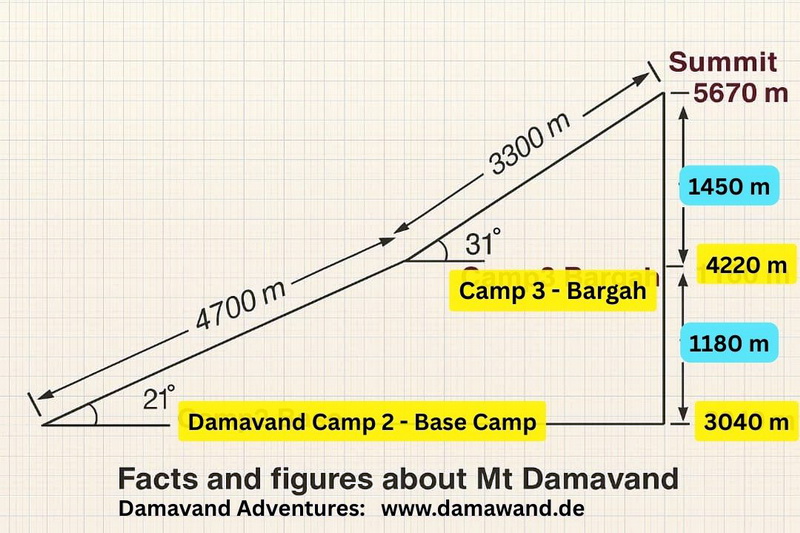
Climbing Facts & Statistics by Ardeshir Soltani
Key Climbing Facts about Mount Damavand, Iran
Mount Damavand Facts, information, tips, and guidance for climbing.
Plan your climb of Mount Damavand with this detailed resource. We provide vital information on climbing routes, weather forecasts, necessary gear, and practical tips, ensuring you're prepared for every step of your journey to the summit.
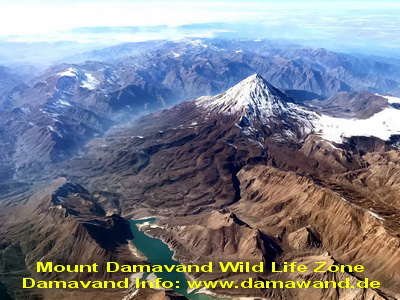
Facts and Information
Mount Damavand: General Facts
- Height: 5,670 m / 18,600 ft
- Prominence: 4,667 m – indicates climbing challenge
- Famous Trekking Routes: South route, West trail, Northeast front, North face
- Coordinates: Latitude 35.954466°, Longitude 52.110020°
- Elevation Gain (South Route): 2,630–2,670 m from base camp to summit
- Average Climbing Time: 10 hours (South Route, base to summit)
- Best Climbing Season: Mid-June to mid-August for trekking; December to mid-May for ski touring
- Difficulty: South route – moderate walk-up (YDS Class 2), North face – steep and most challenging
- Best Hiking Program: 3–5 days
- Best Starting Camps: Polour (South/West routes), Nandal (North/Northeast routes)
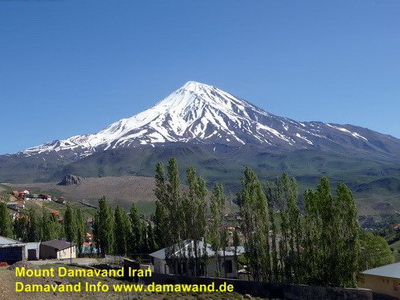
Hike, Trek & Ski Tour – Summer view from Haraz Road and Polour Village
Photo by A. Soltani
Damavand South Route Climbing Facts & Campsites
- Difficulty (Summer): F, YDS Class 2; sulfur gas above 5,400 m
- Route Type: Basic mountaineering, moderate walk-up, easy descent
Major Campsites
- Camp 1 Polour: 2,270 m
- Camp 1 Reyneh: 2,070 m
- Camp 2 Base: 3,040 m
- Camp 3 Bargah Sevom - Shelter: 4,220 m
- Camp 3 Bargah Sevom - New Hut: 4,250 m
Distances Between Camps
- Camp 2 Base to Camp 3 Bargah: 4,700 m
- Camp 3 to Summit: 3,300 m
- Base Camp to Summit: 8,000 m
Vertical Gain
- Camp 2 Base to Camp 3: 1,180 m
- Camp 3 to Summit: 1,450 m
- Total Base Camp to Summit: 2,630 m
Time & Climbing Speed
- Base Camp to Summit: 10 hours (average)
- Average Climb Speed: 800 m/h
Access Distances
- Camp 1 Polour to Camp 2 Base: 17.7 km (11.3 km asphalt + 6.4 km gravel)
- Tehran (Serah TehranPars) to Camp 1 Polour: 73 km
- Tehran IKA Airport to Camp 1 Polour: 133 km
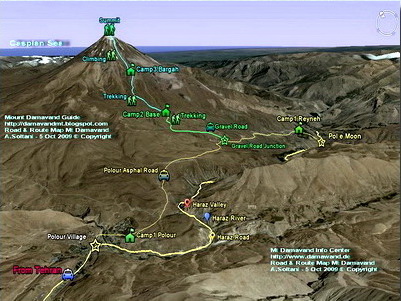
Download Original Size Image
Damavand Ski Touring Facts
- Ski Season: December to mid-May, peak conditions March–April
- Best Ski Route: South Route
- Snow Depth: 2–5 m
- Vertical Ski Drop: Summit to Camp 3 New Hut: 3,300 m; Camp 3 to Camp 2 Base: 4,700 m; Total summit to road: 12,000 m
- Highest Resort Camp: Camp 3 New Hut: 4,250 m
- Lowest Resort Camp: Camp 1 Polour: 2,270 m
- Ski Program: 7-day itinerary
- Guides: Experienced local ski guides available
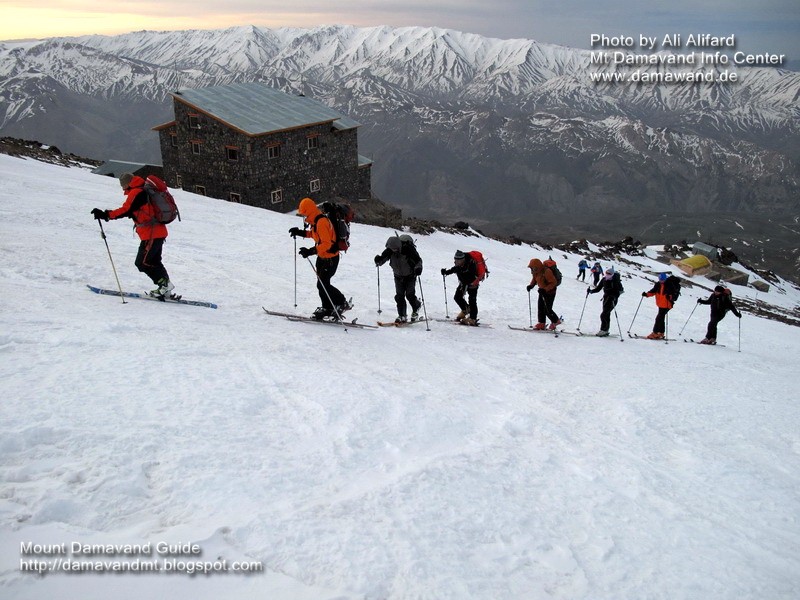
Interesting Damavand Climbing Facts & Figures
Measurements from the South Route are based on GPS, maps, and personal observations:
Base Camp to Summit
- Trail Path Distance: 8,000 m
- Direct Distance: 5,840 m
- Altitude Gain: 2,630 m
- Average Ascend Time: 10 hours
- Average Slope Angle: 26.76°
- Maximum Slope Angle: 39° (4,910–4,973 m)
- Minimum Slope Angle: 11.5° (3,095–3,115 m)
Camp 2 to Camp 3
- Trail Path: 4,700 m
- Height Difference: 1,180 m
- Direct Distance: 3,182 m
- Average Slope: 21.8°
- Max Slope: 33.3° (3,807–3,861 m)
- Min Slope: 11.5° (3,095–3,115 m)
Camp 3 to Summit
- Trail Path: 3,300 m
- Height Difference: 1,450 m
- Direct Distance: 2,687 m
- Average Slope: 31°
- Max Slope: 39° (4,910–4,973 m)
- Min Slope: 12.7° (5,522–5,544 m)
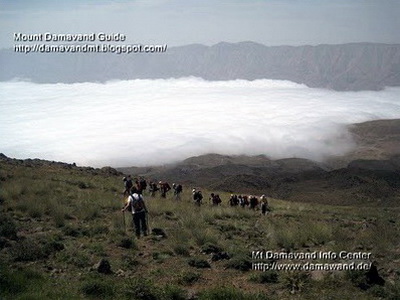
Photo by A. Soltani
Damavand Climbing Facts
Elevation & Prominence
Mount Damavand reaches 5,670 meters (18,600 feet), making it the highest volcano in Asia and the 3rd highest volcano of the volcanic seven summits (V7S). Its conical shape allows climbs from multiple routes.
Climbing Challenges
Damavand’s main challenges are physical endurance, acclimatization, weather, and thin air at high altitudes. Summer climbs are technically easy but physically demanding, while winter ascents involve snow, ice, and severe cold.
Damavand Acclimatization
Ascend to Damavand Iran in summer is not technically difficult but physically it is a hard trek. The main challenge of the climb is acclimatization because the air gets thinner with less oxygen as you go higher. To raise the chance of success and lower the risk of AMS and to enjoy a safe hike to the peak it is essential to get accustomed to this new environment.
Acclimatization Tips
Proper acclimatization is critical to reduce the risk of altitude sickness (AMS). Spend time at intermediate camps, hydrate, and ascend gradually to increase the chance of a safe summit.
For a safe trek to any summit is essential to find the proper accommodation and use the safest campsites in the area. If you intend to attempt Damavand summit either from the classic south route or the west trail, the following campsites are the best places for accommodation and settlement. Camp 1 Polour Resort in Polour Village as the first camp and the best starting point and Camp 3 Bargah New Hut as the high camp.
Damavand Climate
In general terms Mount Damavand has different Climates and seasons for hiking & trekking, climbing and ski touring. Mid-June to mid-September the weather is ideal for summer trekking, November to May the conditions becoming difficult for winter climbing and December to April suitable for ski mountaineering, snowboarding and snowshoeing.
Damavand Difficulty
Damavand is well-known for its mild slops. Hiking Damavand, this 18,600 feet giant volcano is technically easy but physically a tough challenge and requires a good physical fitness. The main challenge of ascend is acclimatization and the weather. Trekking in summer is comparable to Mount Kilimanjaro in Tanzania and Mount Everest Base Camp in terms of Difficulty. But winter climbing is a quite different story and may be compared to a 7000 m peak or more.
Damavand Google Earth
Before actually starting your program to Damawand Mountain in Iran it is a good idea to have a virtual trip by Google Earth and get an impression about the campsites, the best route and the trails, shelters, safe havens and mountain resorts in the area. Install Google Earth software on your computer or your smart phone and follow the tracks.
Damavand GPS
If you want to explore Mount Damawand near Tehran by yourself, GPS Track is the most useful guidance for your expedition. It displays the best possible trail and the suggested footprint. GPS track file is the most helpful tool for trekking Volcano Damavand in Iran. You can upload these files to your handheld gps device to show you the precise location and direction.
Damavand Guide
Recommended pages for trekking and ski touring to Damavand Iran.Best source of information for trekking and ski touring to Mount Damavand.
Damavand Location
Damawand Mountain is located in Larijan district in Mazandaran Province in northern Iran. It is standing on the south coast of the Caspian Sea in the middle of the Alborz Mountains about 80 Km North-East of the capital city Tehran. The coordinates and the GPS landmark of Mount Damavand, Iran south peak is: Latitude 35-57-19 N, Longitude 52-06-37 E.
Damavand Maps
In our websites you can find and download some useful road and route Maps for trekking Mt. Damavand Iran. These helpful maps show you the entire track and footstep details and show you how to start from Tehran and go to the campsites and reach the Damawand peak.
Damavand Timing
Best Timing to trek Damawand Mountain is mid-June to mid-September. In this season the south route ridge and the climbing footpath is usually free of snow. The weather is generally mild in summer and the access by 4WD vehicles to the base camp is possible. Remember in this period the Damavand campsites are crowded in Iranian weekends (Thursday and Friday). The beginners are strongly advised to attempt the mountain only in this climbing season.
Icefalls & Glaciers
On the south route lies the frozen waterfall Abshar Yakhi, about 12 meters tall at 5,100 m – the highest waterfall in Iran and the Middle East. A small glacier exists in the crater, remaining frozen most of the year. Meltwater may form small pools during hot summers.
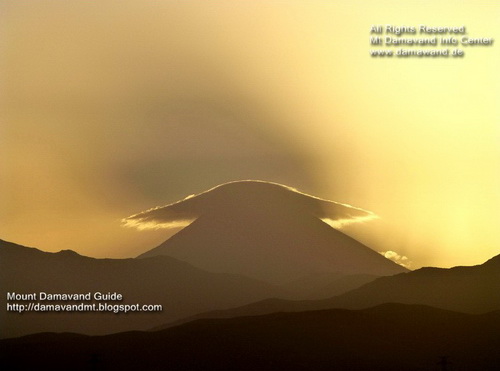
View from Sorkheh-Hesar Park, Tehran
Photo by Ardeshir Soltani
Damavand Climbing Routes
Mount Damavand has sixteen known climbing routes, ranging from easy trekking paths to advanced rock climbing. Four main routes are the most popular due to mid-way shelters and campsites:
- South Route (Popular Route): Most popular and beginner-friendly. Starting from Polour Village (2,200 m) and overnight at Bargah Sevom New Hut (4,250 m). Clear trails and excellent mountain resorts make this the safest and most recommended route for trekking tours. Constructed in 2008 by the Iranian Mountaineering & Sport Climbing Federation, this route has easy access from Tehran.
- West Route (Shortest Route): The shortest route, starting from Polour Village with overnight at Simorgh Refuge (4,200 m). Offers moderate difficulty, basic mountaineering, walk-up sections, snow and cold exposure, and a challenging descent. Famous for sunset views.
- North-East Route (Gazaneh Trail, Longest Route): Longest trail, taking two days to summit. Starts at Nandal Village with overnight at Takht-e Fereydoun shelter (4,500 m). Typical mountaineering with long trail difficulty, hard ascent with cold wind, and long descent.
- North Face (Most Difficult Route): Steep, icy, and challenging. Includes shelters at 4,000 m and 5,000 m. Requires scrambling mountaineering, and route difficulty depends on season, cold, wind, snow, and ice.
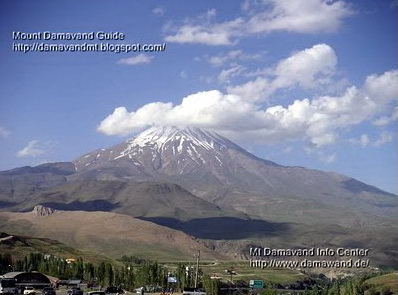
Highest Peak in the Middle East – 5,671 m (18,605 ft)
Tallest volcano in Asia and the second-highest volcano in the Northern Hemisphere
Photo by A. Soltani
Mount Damavand Climbing Facts – FAQs
Mount Damavand has sixteen known routes, but the four main routes are the South Route (most popular), West Route, North-East Route (Gazaneh Trail), and North Face. Routes vary in difficulty, trail length, and required climbing skills.
The South Route is recommended for beginners due to clear footpaths, accessible campsites, moderate slopes, and a relatively safe ascent. Guided support is strongly advised for first-time climbers.
Most climbers take 2–3 days via the South Route, including overnight at Camp 3 Bargah Sevom or the New Hut. Longer routes like the North-East Trail require two full days, and the North Face may require advanced technical planning.
From South Route Base Camp to the summit, the total altitude gain is approximately 2,630 meters (8,630 feet), with Camp 2 Base to Camp 3 gaining 1,160 meters, and Camp 3 to summit gaining 1,470 meters.
The South Route is a moderate walk-up (YDS Class 2), while the West Route involves basic mountaineering with a more challenging descent. The North-East Route is long and physically demanding, and the North Face is steep, technical, and suitable only for experienced climbers.
Main campsites include Camp 1 Polour (2,270 m), Camp 1 Reineh (2,070 m), Camp 2 Base (3,040 m), and Camp 3 Bargah Sevom/New Hut (4,220–4,250 m). These provide shelter, acclimatization points, and safe resting places along the route.
Average climbing speed is approximately 800 meters per hour. Base Camp to summit typically takes around 10 hours of ascent, usually spread over 1–2 days depending on acclimatization and fitness.
The South Route features Abshar Yakhi, a 12-meter frozen waterfall at 5,100 m. The crater also contains a small glacier, usually frozen year-round. Climbers should be aware of snow, ice, and steep sections depending on the season.
Yes. Experienced guides significantly increase safety, help with acclimatization, and improve chances of successfully summiting, especially for beginners or those unfamiliar with the mountain.
Summer (mid-June to mid-August) is the safest and easiest period for trekking. Winter climbs are much more challenging due to snow, ice, and strong winds, and should only be attempted by experienced mountaineers.

Mount Damavand is not just the highest mountain in Iran, it is also a revered symbol of Iranian pride and natural beauty. This guide provides valuable insights into the location, key statistics, and historical significance of the mountain. Learn about Damavand’s volcanic activity, its towering height of 5,671 meters, and its place in Persian mythology. With comprehensive details about climbing routes, environmental challenges, and cultural relevance, this resource offers all the insights you need to understand the grandeur of Mount Damavand.
Camp at the Foot of Mount Damavand
Damavand Camp, also called Damavand Base Camp, Damavand Camp II, or the mountain’s second camping area, is locally known as Goosfand-Sara (گوسفند سرا ), which means "sheepfold," or the Saheb al-Zaman Mosque (مسجد صاحب الزمان ) campsite. It’s a crucial stop for climbers and trekkers getting ready to ascend Mount Damavand, offering basic facilities for rest and preparation.
This camp is the most popular and easiest to reach for those setting out to conquer Mount Damavand. Its simple but practical amenities include a small mountain shelter, the Saheb al-Zaman Mosque, and a sheepfold. Located at an altitude of 3,040 meters, with coordinates Latitude 35.9020° and Longitude 52.1094°, it serves as the key base camp for climbers tackling the south route, particularly in the summer season. It provides a resting point before beginning the challenging ascent.
Damavand Trekking Tour Packages
Trekking tour packages for Mount Damavand provide an all-inclusive experience for adventurers eager to explore this magnificent mountain. These packages typically include guided tours, transportation, accommodations, and meals, allowing you to focus on enjoying your trek without worrying about logistics. Whether you’re tackling the South Route or exploring other trails, these packages ensure a well-rounded and enjoyable adventure tailored to your interests. Experienced guides will lead you through stunning landscapes, ensuring you have a safe and memorable journey filled with breathtaking sights and rich cultural experiences throughout your exploration of Mount Damavand.
Best Trekking Guides in Mount Damavand’s Adventure
The Role of Certified Guides in Mount Damavand’s Unique Adventure. The role of a certified guide goes beyond just leading the way; they enhance the entire adventure. Damavand mountain guides are highly skilled professionals who understand every aspect of the mountain, from the best climbing routes to the most scenic areas for photography. They ensure climbers are properly acclimatized and provide essential safety measures throughout the trek. With certified guides by your side, you can fully immerse yourself in the experience while knowing that you are in expert hands.